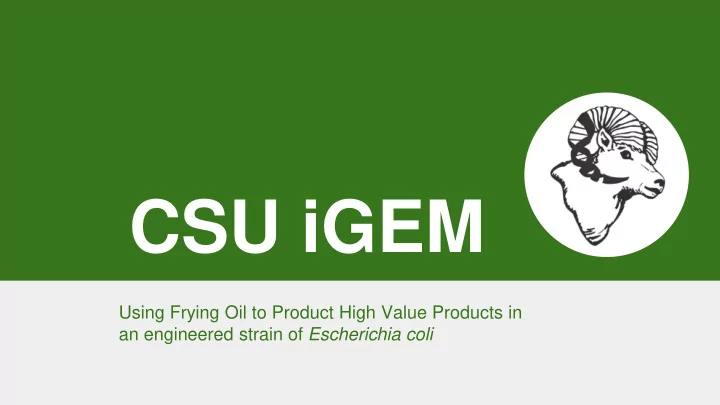

CSU iGEM Using Frying Oil to Product High Value Products in an engineered strain of Escherichia coli
2014 Team Advisers Dr. Christie Peebles Dr. Ashok Prasad Jiayi Sun, Graduate Adviser Students Krista Henderson Adriana Collings Matt Sabel Anthony Roulier Olivia Smith Chauncy Hinshaw Renee Plomondon Josiah Racchini Savannah Roemer
Our Story
Overview of Project Breaking down used frying oil to produce a value-added terpenoid Spent frying oil can be used to power cars, but there are still 3 billion gallons of spent frying oil produced each 1. US EPA. “ Learn About Biodiesel ” . Web. 8 Jan 2014. Retrieved 20 Aug 2014. 2. Photograph courtesy of Dan Dickinson. Used with permission under creative commons with attribution. year in the U.S.
Project Components 1. Biosensor 2. Breakdown of frying oil 3. High-value product 4. Kill switch
Biosensor - Goal ● Detect the presence of fatty acids ● Function as the promoter for breakdown ● No unnecessary stress without oils present
Biosensor - Background Fatty Acids Absent No GFP production Fatty Acids Present GFP Produced Zhang, et. al. "Design of a Dynamic Sensor-regulator System for Production of Chemicals and Fuels Derived from Fatty Acids." Nature Biotechnology 30.4 (2012): 354-59. Web.
Biosensor - Approach and Results ● Assemble 4 promoters from 4 sequenced oligonucleotides ○ Chose PAR and PFL1 ● Link to GFP for testing Future Work: ● Use fully synthesized gene ● Integrate into breakdown
Breakdown of Frying Oil - Goal ● Breakdown used frying oil products ● Create metabolic intermediate Fatty Acid Beta- Mevalonate Acetyl-CoA Oxidation Pathway
Breakdown of Frying Oil ● Frying oil is made of triacylglycerol o heating makes diacylglycerol fatty acids ● The fatty acids are broken down by the beta oxidation cycle ● FadD is the rate limiting step Dobarganes, M. Carmen. “Formation of New Compounds during Frying - General Observations.” AOCS Lipid Library. Web. 2 February 2009. June 2014.
Breakdown of Frying Oil Upregulate Beta-Oxidation ● Test by linking to lac promoter ● Eventually link to biosensor promoter ● Creates acetyl-CoA for use in high-value product manufacturing Zhang, Hanxing, et al. “Molecular effect of FadD on the regulation and metabolism of fatty acid in Escherichia coli.” FEMS Microbiology Letters, 2. Web. 16 May 2006. June 2014. Kameda, Kensuke, et al. “Purification and Characterization of Acyl Coenzyme A Synthase from Escherichia coli.” The Journal of Biological Chemistry, 11. Web. 10 June 1981. June 2014.
High-Value Product: Goal ● Acetyl-CoA → IPP → Terpenoid Martin, Vincent J., Douglas J. Pitera, Sydnor T. Withers, Jack D. Newman, and Jay D. Keasling. "Engineering a Mevalonate Pathway in Escherichia Coli for Production of Terpenoids." Nature Biotechnology 21.7 (2003): 796-802. PubMed.gov . Web. 27 June 2014.
High-Value Product: Background ● 2 pathways ● Mevalonate and MEP Martin, Vincent J., Douglas J. Pitera, Sydnor T. Withers, Jack D. Newman, and Jay D. Keasling. "Engineering a Mevalonate Pathway in Escherichia Coli for Production of Terpenoids." Nature Biotechnology 21.7 (2003): 796-802. PubMed.gov . Web. 27 June 2014.
High-Value Product: Approach ● Created plasmids to put mevalonate pathway into E. coli ● Based on constructing two operons from yeast genes ( S. cerevisiae) Martin, Vincent J., Douglas J. Pitera, Sydnor T. Withers, Jack D. Newman, and Jay D. Keasling. "Engineering a Mevalonate Pathway in Escherichia Coli for Production of Terpenoids." Nature Biotechnology 21.7 (2003): 796-802. PubMed.gov . Web. 27 June 2014.
Kill Switch: Goal ● Toggleable low-leak kill switch o Specific conditions o Low stress o Highly-efficient
Kill Switch: Background ● Tryptophan Repressor (BBa_K588001) o Control of KillerRed expression ● KillerRed gene o Reactive Oxygen Species Bulina, M., et. al. "A genetically encoded photosensitizer .” Nature Biotechnology, 95-99. 2005. October 2014.
Kill Switch: Approach ● Trp + GFP Plasmid ● Trp+ KR Plasmid ● Kill curve of KR plasmid Bulina, M., et. al. "A genetically encoded photosensitizer .” Nature Biotechnology, 95-99. 2005. October 2014.
Low Stress Design ● Allocates resources to necessary functions o Promotes growth and survival o Prevents cell from producing products when unneccessary o Reserves energy for cell
Safety Workplace safety programs can decrease chances of injury by up to 50% 1. Safety Services Company. “10 Tweetable Facts About Workplace Safety” . Web. Jul 2012. Retrieved Sep 2014. 2. Photograph courtesy of Michigan School of Natural Resources and Environment. Used with permission under creative commons with attribution.
Future Directions ● Combination of components into single continuous pathway ● Optimization of pathway ● Optimization of environmental conditions ● Economic feasibility analysis
Human Practices ● University of Colorado - Boulder collaboration ● Tested one of their biobricks before submission
Human Practices ● Outreach at elementary school ● Conducted experiments with Science Club
Thank You Thank you to our advisers, iGEM, sponsors, and other teams for making this competition and our project possible.
Acetyl-CoA Production Produce one acetyl- CoA per 2 carbons in the fatty acid backbone Image courtesy of PharmaChange.info
Terpenoids Created from combination of isoprene units via condensation reaction 1. Images (left and top right) courtesy of Cyberlipid Center 2. Image (bottom right) courtesy of Simon Cotton Examples of terpenoids
Plant vs Bacterial Extraction ● Current yields: ~500 mg/L ● Order of magnitude increase in yield may be possible 1. Ajikumar, Parayil Kumaran, et. al. “ Terpenoids: Opportunities for Biosynthesis of Natural Product Drugs Using Engineered Microorganisms .” 2. Image (left) courtesy of German Plant Breeders' Association 3. Image (right) courtesy of Scientific American Magazine
Determining Kill Switch ● KillerRed Info: o Ordered via Evrogen o 239 aa length, 27kDa o Maximum Wavelength: 610 nm ● Alternative Choice: Heme Pathway o Removal of HemH gene causes protoporphyrin overproduction o excess protoporphyrin causes ROS buildup resulting in cell lysis
Recommend
More recommend